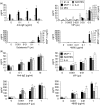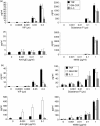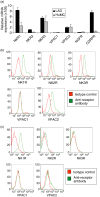Neuropeptides activate human mast cell degranulation and chemokine production
- PMID: 17922833
- PMCID: PMC2433325
- DOI: 10.1111/j.1365-2567.2007.02705.x
Neuropeptides activate human mast cell degranulation and chemokine production
Abstract
During neuronal-induced inflammation, mast cells may respond to stimuli such as neuropeptides in an FcepsilonRI-independent manner. In this study, we characterized human mast cell responses to substance P (SP), nerve growth factor (NGF), calcitonin gene-related peptide (CGRP) and vasoactive intestinal polypeptide (VIP) and compared these responses to human mast cell responses to immunoglobulin E (IgE)/anti-IgE and compound 48/80. Primary cultured mast cells, generated from CD34(+) progenitors in the presence of stem cell factor and interleukin-6 (IL-6), and human cultured mast cells (LAD2) were stimulated with these and other stimuli (gastrin, concanavalin A, radiocontrast media, and mannitol) and their degranulation and chemokine production was assessed. VIP and SP stimulated primary human mast cells and LAD cells to degranulate; gastrin, concanavalin A, radiocontrast media, mannitol, CGRP and NGF did not activate degranulation. While anti-IgE stimulation did not induce significant production of chemokines, stimulation with VIP, SP or compound 48/80 potently induced production of monocyte chemoattractant protein-1, inducible protein-10, monokine induced by interferon-gamma (MIG), RANTES (regulated on activation, normal, T-cell expressed, and secreted) and IL-8. VIP, SP and compound 48/80 also activated release of tumour necrosis factor, IL-3 and granulocyte-macrophage colony-stimulating factor, but not IL-4, interferon-gamma or eotaxin. Human mast cells expressed surface neurokinin 1 receptor (NK1R), NK2R, NK3R and VIP receptor type 2 (VPAC2) but not VPAC1 and activation of human mast cells by IgE/anti-IgE up-regulated expression of VPAC2, NK2R, and NK3R. These studies demonstrate the pattern of receptor expression and activation of mast cell by a host of G-protein coupled receptor ligands and suggest that SP and VIP activate a unique signalling pathway in human mast cells. These results are likely to have direct relevance to neuronally induced inflammatory diseases.
Figures









References
-
- Bienenstock J, MacQueen G, Sestini P, Marshall JS, Stead RH, Perdue MH. Mast cell/nerve interactions in vitro and in vivo. Am Rev Respir Dis. 1991;143:S55–S58. - PubMed
-
- Singh LK, Pang X, Alexacos N, Letourneau R, Theoharides TC. Acute immobilization stress triggers skin mast cell degranulation via corticotropin releasing hormone, neurotensin, and substance P. A link to neurogenic skin disorders. Brain Behav Immun. 1999;13:225–39. - PubMed
-
- Ferry X, Brehin S, Kamel R, Landry Y. G protein-dependent activation of mast cell by peptides and basic secretagogues. Peptides. 2002;23:1507–15. - PubMed
-
- Janiszewski J, Bienenstock J, Blennerhassett MG. Picomolar doses of substance P trigger electrical responses in mast cells without degranulation. Am J Physiol – Cell Physiol. 1994;267:C138–C145. - PubMed
-
- Okayama Y, Ono Y, Nakazawa T, Church MK, Mori M. Human skin mast cells produce TNF-alpha by substance P. Int Arch Allergy Immunol. 1998;117:48–51. - PubMed
Publication types
MeSH terms
Substances
Grants and funding
LinkOut - more resources
Full Text Sources
Other Literature Sources
Research Materials

